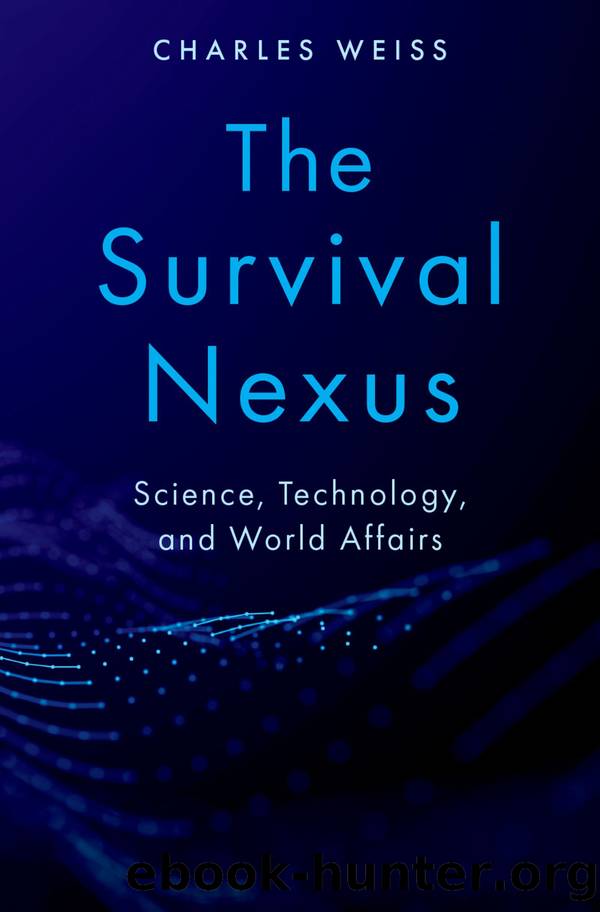The Survival Nexus by Charles Weiss;

Author:Charles Weiss;
Language: eng
Format: epub
Publisher: OUP Premium
Published: 2021-12-15T00:00:00+00:00
First Steps Toward Rules of the Road for Cyberconflict
Developing norms for cyberwarfare is likely to take time. As in the case of nuclear arms control, the evolution of norms concerning cyberattack is hindered by the deep ideological divide between democratic and authoritarian powers. Democratic powers prefer to concentrate on norms related to attacks on critical physical and digital infrastructure, and to argue that existing laws of war can be extended and adapted to such attacks. To most authoritarian governments, in contrast, the free flow of information is a threat to political and social stability and hence is viewed as a form of cyberattack. Even so, both sides share an interest in avoiding a cyber-apocalypse that causes extensive damage to their cyber-controlled infrastructure. Similarly, the shared interest in avoiding nuclear war drove deeply hostile nuclear superpowers to arrive at nuclear arms control regimes during the Cold War. Nevertheless, it took more than a decade of careful analysis and negotiation, involving academics, military officers, thinktanks, nonprofit organizations, and government diplomats from many countries to agree to these regimes. There is a similar need for norms governing the application of geoengineering and gene driver technologies, although for different reasons that we shall discuss in chapter 12.
The most important contribution of the democratic powers to these issues date is the Tallinn Manual, now in its second, 2.0 version. This is an authoritative, 562-page restatement of existing international law as it applies to the use of cyberweapons, both in war and in peacetime.35 The Tallinn Manual was developed from a consensus of the personal views of experts at a series of meetings at a NATO cybersecurity think tank in Tallinn, Estonia. It does not have the status of an official NATO document but it has been endorsed by the high-level Disarmament Committee of the United Nations. On the substantive side, the Tallinn Manual suffers from the important limitation that it considers a cyberattack to constitute an act of war only if it results in physical damage to the target. This does not correspond to historical experience, as, for example, the Russian attacks on Georgia and Estonia described earlier. To date, the only time that war has been threatened in response to a cyberattack occurred in 2016, when President Barack Obama threatened war if Russia attacked the mechanics of the 2016 election.36
On the multilateral front, the UN Group of Governmental Experts (UNGGE) on cybersecurity agreed in 2015 on norms calling for international cooperation, governments taking responsibility for acts that take place within the borders of their country, refraining from attacks on emergency response teams or on civilian or other critical infrastructure, reporting vulnerabilities when they are discovered, and providing technical assistance to countries that need and request it. The norms called for respect for the right of privacy but were somewhat ambiguous on the broader question of whether human rights law should apply in cyberspace.37 When follow-up meetings failed to reach further agreement, the UN established a working group of government delegations to continue to seek common ground.
Download
This site does not store any files on its server. We only index and link to content provided by other sites. Please contact the content providers to delete copyright contents if any and email us, we'll remove relevant links or contents immediately.
Zero to IPO: Over $1 Trillion of Actionable Advice from the World's Most Successful Entrepreneurs by Frederic Kerrest(4041)
Harry Potter and the Goblet Of Fire by J.K. Rowling(3604)
Machine Learning at Scale with H2O by Gregory Keys | David Whiting(3604)
Never by Ken Follett(3516)
Ogilvy on Advertising by David Ogilvy(3324)
Shadow of Night by Deborah Harkness(3169)
The Man Who Died Twice by Richard Osman(2801)
Book of Life by Deborah Harkness(2714)
My Brilliant Friend by Elena Ferrante(2697)
How Proust Can Change Your Life by Alain De Botton(2608)
0041152001443424520 .pdf by Unknown(2591)
Will by Will Smith(2572)
The Tipping Point by Malcolm Gladwell(2553)
How to Pay Zero Taxes, 2018 by Jeff A. Schnepper(2496)
Purple Hibiscus by Chimamanda Ngozi Adichie(2478)
Hooked: A Dark, Contemporary Romance (Never After Series) by Emily McIntire(2410)
Rationality by Steven Pinker(2146)
Borders by unknow(2115)
Daughter of Smoke and Bone by Laini Taylor(2076)
